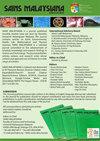Assessment of Genetic Diversity and Relatedness of Local Banana (Musa spp.) Cultivars in Malaysia Using Simple Sequence Repeat (SSR) Markers
IF 0.7
4区 综合性期刊
Q3 MULTIDISCIPLINARY SCIENCES
引用次数: 0
Abstract
Banana (Musa spp.) is an economically important crop widely consumed all over the world. Understanding the genetic diversity and relatedness between various banana cultivars is important to continuously improve its fruit characteristics, nutritional value, and disease resistance. This study aimed to develop a DNA fingerprinting panel using polymorphic simple sequence repeat (SSR) markers for the genetic characterisation of 11 banana cultivars in Malaysia. A total of 10 polymorphic SSR markers were developed into a multiplex PCR reaction and capillary electrophoresis to uniquely profile our collection of banana cultivars. The developed fingerprinting panel successfully amplified a total of 95 alleles, with 6 to 13 alleles per SSR marker. The average SSR marker polymorphic information content (PIC) value is 0.812, indicating the informativeness of the panel. Analysis of molecular variance (AMOVA) shows that 97% of the molecular variance from our banana collection is due to inter-variety genetic diversity, while the remaining 3% is due to intra-variety genetic diversity. A population structure analysis groups our collection of banana varieties according to the presence of at least one M. balbisiana (B) genome in their genetic makeup. The Cavendish variety, however, showed a distinct structure compared to the other cultivars. This SSR fingerprinting panel provides valuable insights into the genetic diversity and relatedness between banana cultivars in Malaysia. It has the potential to assist future banana breeding initiatives and serve as an effective quality control measure for verifying varieties in a tissue culture facility involved in banana planting materials production.利用简单序列重复 (SSR) 标记评估马来西亚当地香蕉(Musa spp.)
香蕉(Musa spp.)了解各种香蕉栽培品种之间的遗传多样性和亲缘关系对于不断改进其果实特性、营养价值和抗病性非常重要。本研究旨在利用多态性简单序列重复(SSR)标记开发一个 DNA 指纹图谱面板,以确定马来西亚 11 个香蕉栽培品种的遗传特征。通过多重 PCR 反应和毛细管电泳,共开发出 10 个多态性 SSR 标记,对我们收集的香蕉栽培品种进行了独特的分析。所开发的指纹识别面板共成功扩增出 95 个等位基因,每个 SSR 标记有 6 至 13 个等位基因。SSR 标记的平均多态信息含量(PIC)值为 0.812,表明该面板的信息量很大。分子方差分析(AMOVA)显示,我们的香蕉样本中 97% 的分子方差来自品种间的遗传多样性,其余 3% 来自品种内的遗传多样性。种群结构分析根据香蕉品种的遗传结构中至少存在一个 M. balbisiana (B) 基因组对香蕉品种进行了分组。然而,与其他品种相比,卡文迪许(Cavendish)品种显示出独特的结构。这个 SSR 指纹图谱小组为了解马来西亚香蕉栽培品种的遗传多样性和亲缘关系提供了宝贵的信息。它有潜力协助未来的香蕉育种计划,并可作为一种有效的质量控制措施,在香蕉种植材料生产的组织培养设施中验证品种。
本文章由计算机程序翻译,如有差异,请以英文原文为准。
求助全文
约1分钟内获得全文
求助全文
来源期刊

Sains Malaysiana
MULTIDISCIPLINARY SCIENCES-
CiteScore
1.60
自引率
12.50%
发文量
196
审稿时长
3-6 weeks
期刊介绍:
Sains Malaysiana is a refereed journal committed to the advancement of scholarly knowledge and research findings of the several branches of science and technology. It contains articles on Earth Sciences, Health Sciences, Life Sciences, Mathematical Sciences and Physical Sciences. The journal publishes articles, reviews, and research notes whose content and approach are of interest to a wide range of scholars. Sains Malaysiana is published by the UKM Press an its autonomous Editorial Board are drawn from the Faculty of Science and Technology, Universiti Kebangsaan Malaysia. In addition, distinguished scholars from local and foreign universities are appointed to serve as advisory board members and referees.
 求助内容:
求助内容: 应助结果提醒方式:
应助结果提醒方式:


